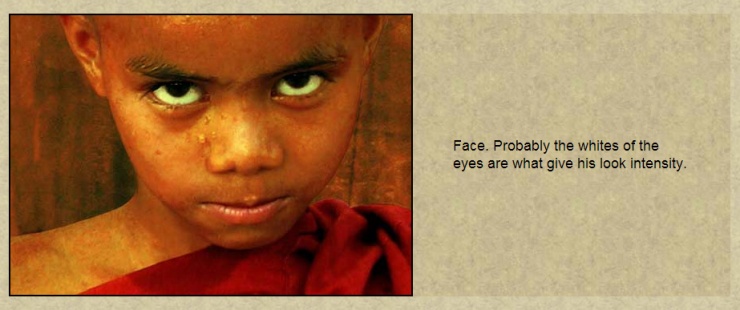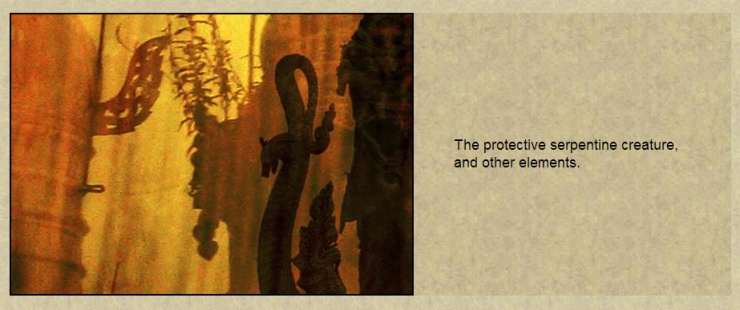
Composed of several photos I took in Burma/Myanmar, I think there’s enough ambiguity (such as in terms of the boy’s expression) to avoid a clichéd depiction of a Buddhist monk, while also having a palpable mystical quality (especially in the shadowy, undulating backdrop). Incidentally, I created this while living in a one room cabin in the mountains of Santa Barbara, where my restroom was a bucket of sawdust.
Process
A lot of my images required a lot of drawing, but this one was done purely using standard Photo Shop techniques: masking and reverse masking, stacking photos, collage, and adjustment layers… Below are most the photos I used to compose the image.
These boys basically stalked me through the temple grounds and demanded that I photograph them. I took a few perfunctory snaps, and only on later inspection noticed the intriguing pose and expression of the boy who, for whatever reason, placed himself front-and-center. Other than that there’s nothing exceptional about the photo.
Left above: I used the reflection on green painted glass in the window as a background, though didn’t keep the color, even though it’s spectacular.
Right above: The photo barely rises above drab, but the silhouette became powerful when I layered it among other imagery in the background. Of course, I made it appear much larger than it really is.
I don’t know the correct word for this creature in Burmese, but in Thailand it’s called a “Naga,” and represents a serpent that shaded and protected the Buddha. They often appear at the fronts of Buddhist temples and are otherwise used as decorative motifs. I don’t remember why I bothered to integrate this element into the piece, as I’m not sure it adds much, but there it is.
Close-ups / Details
Meaning / Interpretation
If this were intended as travel photography, it would be dastardly. I have hundreds of travel shots of Burma/Myanmar, but generally a photo is a mechanical reproduction of the outward physical appearance of something at a specific split second in time. Is there any reason we should believe that such a mechanism could capture the internal state or condition of a person or situation if it weren’t accurately and sufficiently outwardly expressed? How often are we ever definable in a flashing instant, and not in the middle of a sentence?
There’s a description in the Lonely Planet of the Shwedagon Pagoda in Yangon, Myanmar as “dripping with spirituality,” and while one may sense some of that while present it’s quite difficult to capture it with straight photography, especially if one doesn’t have a wide angle lens. I rarely find that any single photograph I take can capture a feeling about something. One of my fellow graduate students in art once aptly addressed this in pointing out that photographs of food didn’t make her hungry, despite every attempt to make those images appear appetizing. The sensation of taste doesn’t transfer to a still image any more than a photo of musicians captures their music. This isn’t to say that visual art is mute, rather that straight photography is ideal for certain types of expression and documentation, but in the hands of most of us certainly doesn’t automatically arrest the underlying meaning or content of a subject by merely registering its outward appearance mechanically.
This isn’t to say that I think subjective experience trumps logic and facts. No way. Relative to the image on this page, I find it an interesting fact that at the temple in Bangkok where I spent 10 days meditating, the Abbot there informed me that the time when the temple received the most visitors was the day before the lottery. But facts and information don’t matter to computers, they only matter to living beings who are vulnerable and perishable in the world, and to the degree they have some bearing an a person’s being. I do think, though, that if the majority of people acted in a reasonable and logical way most the world’s problems would disappear, since they are primarily the consequence of selfish stupidity, which is ultimately unreasonable.
The image I produced is something one would never see in Burma even though I photographed all the components there. Nor does it accurately reflect the nature of the boy or Buddhism, I wouldn’t think. It’s more a reflection of my subjective experience and interpretation of the material, and my projection of my own inner psyche. Some may conclude that it isn’t “real” because it is heavily manipulated, and at very least a collage. I might counter that while it is definitely not factual, being infused with more than meets the eye (if one agrees that the total is more than the sum of it’s parts) doesn’t make it less meaningful, substantive, or real. All of our experience, including our perception and appreciation of the driest facts, is inherently subjective, taking place on the inner screen of our own consciousness, and unverifiable and impossible to locate using any scientific instruments. In other words, if subjectivity isn’t real, than neither is 100% of our mental experience, since it’s unverifiable and untraceable.
If the goal were to create something that were, for example “dripping with spirituality,” would the best way to achieve it be to evoke it, or to define it? Would a song or a schematic drawing be more effective? In this instance I was partly trying to create a kind of transcendent moment that religious monuments in broad daylight, or people dressed in the appropriate garb aren’t likely to exude. Beyond that I find that the boy, the color scheme, and the background, while all quite textured with mystical residue, are ambivalent. It’s fiery hot and the boy is visibly sweating. Is he welcoming, challenging, forbidding… I can see people having very different and even opposite reactions to this image, depending on their own interpretations (some of which I probably wouldn’t like or agree with). As regards my intentions, however, as with my other recent images, I tried to portray that which transcends or falls outside our day-to-day consensual reality as possessing awe, and thus potentially calming or unsettling, ecstatic or terrifying.
Prints for sale.











I like when you explain how you do things because you are such a photoshop guru. It’s fascinating and I like these kinds of ‘through the backdoor perspectives’. Your LP paragraph was nice too.
LikeLike
Yeah, I started including stuff about the process because if you work digitally, people tend to think you just clicked some buttons and the computer did all the hard work. Though most people who work with computers DO tend to that kind of schlock art, using “stock photos” to make unicorns or angels and other cliched crap-O-la.
LikeLike
Seconding Lani’s comment, it would be good to see more of these dissections.
LikeLike
There’s a lot more where that one came from, so, no problemo.
LikeLike